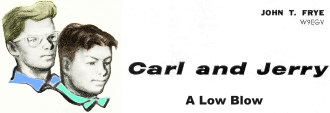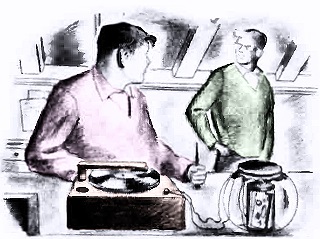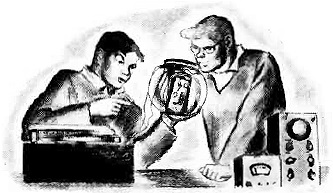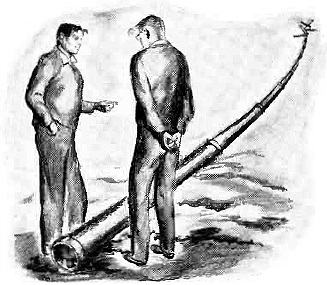|
March 1961 Popular Electronics
 Table of Contents Table of Contents
Wax nostalgic about and learn from the history of early electronics. See articles
from
Popular Electronics,
published October 1954 - April 1985. All copyrights are hereby acknowledged.
|
John T. Frye's "Carl &
Jerry" technodramas™ are always both eventful and instructive in the realm of
electronics and physics, but Mr. Frye really outdoes himself with this "A Low
Blow" episode from the March 1961 issue of Popular Electronics
magazine. The gist of the story is how they boys construct and use an
"infrasonic" microphone to detect low audio frequency sounds. Information
provided by the
National Bureau of Standards (NBS, now the National Institute of Standards
and Technology - NIST) served as the basis for designing and implementing a
measurement system that ultimately resulted in a situation which provided the
title "A Low Blow." You might be surprised to learn that low frequency sound
waves are subject to atmospheric properties similar to radio waves, which can
produce areal skipping and hopping phenomena where reception is possible only in
certain regions between the source and the receiver. This is a very
interesting read.
Carl & Jerry: A Low Blow
 By John T. Frye W9EGV By John T. Frye W9EGV
It was two whole weeks since Carl and Jerry had talked face to face. Jerry had
been home from school sick with influenza, and the boys' parents had kept them apart
to prevent Carl's catching the virus infection. The two had managed to keep in touch
by chatting on the phone, by talking over their ham stations, and -since their bedroom
windows faced each other -even by blinking Morse code on flashlights from one window
to the other. But Jerry had finally recovered sufficiently to be down in his basement
laboratory this warm, windy Saturday morning, and to have Carl visit him.
"Hi, Jer," Carl said gruffly as he came in through the outside basement door.
"How's my puny pal? You look kinda pale around the gills."
Jerry turned away from the large, wide-mouthed glass jar sitting on the workbench
in front of him to bestow a fierce scowl on his friend.
 "Don't 'puny pal' me, you big ox! Disgustingly healthy people make me sick!" "Don't 'puny pal' me, you big ox! Disgustingly healthy people make me sick!"
"Now, now, there" Carl murmured with mocking solicitude. "We mustn't get upset.
Remember: we are not well. And what are we doing with that goldfish bowl ?"
"I am getting ready to test my infrasonic microphone," Jerry said curtly, turning
back to the fishbowl that had a thin membrane of rubber stretched over the top.
Inside was a small, brass-topped glass jar containing some transistors and other
components mounted on a little circuit board. Two tiny twisted wires of the sort
used in record-player tone arms came out of a wax-sealed hole in the
bottom of the jar, ran up over the edge of the bowl beneath the rubber membrane,
and were connected to the input of a tape recorder sitting on the workbench.
"I need more information than that," Carl cheerfully confessed. "What is this
'infrasonic' jazz? I've never heard you mention a project like that before!"
"In physics you should have learned that sound recognized as such by the human
ear goes down in frequency to about 12-15 cycles," Jerry explained; "but there
are other compression and rarefaction waves in the atmosphere at much lower frequencies.
These are called 'infrasonic waves,' and we are surrounded by them even when our
ears hear nothing.
They obey the same laws as sound waves: their speed varies as the product of
the square root of the absolute temperature and a constant related to the conducting
medium.
"At 32°F," he continued, warming to the subject, "sound travels about 1087 feet
per second in air, and the speed increases as the temperature rises. The rate at
which sound power is absorbed and dissipated into heat depends on the frequency.
The fraction of sound power absorbed per unit distance of propagation is roughly
proportional to the square of the frequency. That explains why you hear the bass
drum of an approaching band first, and it also means that only low inaudible frequencies
can be propagated great distances."
Carl started to say something, but Jerry didn't give him a chance.
"When the volcano Krakatoa exploded in 1883 in the East Indies, inaudible waves
from this disturbance traveled around the world several times with a pressure so
great that it produced readable deflections on barographs. The impact of the great
meteor that fell in Siberia in 1908 had the same result. During World War I, it
was noticed that cannon fire could be heard within a radius of 100 kilometers, and
often beyond 200 km., but not between 100 and 200 km."
"The sound waves must have been skipping the way our radio waves do," Carl noted.
"Exactly! Observers figured that something far above the earth must be deflecting
the sound waves back down. The only thing that could do so would be a layer of air
warmer than the air at the earth's surface which would speed up the top edge of
the sound wave entering it at an angle and bend the wave back toward the earth.
By listening for the lowest audible frequencies and by checking the transit time
of the wave from the source to the distant observer, those smart cookies figured
out where and how warm that layer of air had to be! Very recent information gathered
by our space probes confirmed their calculations.
"As you go up in a quiet atmosphere," Jerry went on, "the temperature falls sharply
at first and then zigzags back and forth until you reach an altitude of about 105
km. From that point on up, for at least a considerable distance, the temperature
increases steadily, reaching much higher values than here -"
"Just a cotton-picking minute," Carl interrupted. "You didn't know all this
when you got sick. How did you get so smart?"
"Some time back," Jerry explained, "I noticed a newspaper article about how the
National Bureau of Standards was carrying on experiments on the detection and recording
of infrasonic waves. I wrote the Bureau asking for more information, and Mr. Paul
Walsh and Mr. Donald M. Caldwell kindly sent me a lot of interesting information
about their installation near Washington, D. C."
"How do they work it?"
They have four infrasonic microphones set up at different locations several miles
apart. Signals from each mike are fed to a central location where they are amplified,
bandpass-filtered, and recorded as ink-on-paper traces. By noticing the difference
in time of the signal's arrival at various mike locations, its speed and source-direction can be determined."
"I can't imagine what sort of mike you'd use to pick up signals of one or two
cycles per minute," Carl muttered with a thoughtful frown.
"Neither could I," Jerry agreed, "but the dope I got says the mike is a condenser
type with a diaphragm of thin, specially-formed brass mounted on a reference volume.
One side of the diaphragm connects to a noise-reducing pickup pipe. Movements of
the diaphragm modulate the frequency of an oscillator."
"I see - I think," Carl said doubtfully, "but what's this about a noise-reducing
pipe ?"
"When the mike diaphragm is exposed directly to the open air, pressures produced
by the wind develop a lot of signal-masking noise. These specially designed metal
pipes lie on top of the ground and are each about 1000 feet long. Each pipe has
100 small holes distributed along its length. A signal traveling toward the microphone
along the length of the pipe is attenuated very little, but random variations in
pressure caused by wind turbulence are greatly reduced."
"What sort of sounds, or whatever you call 'em, are picked up?"
"Well, on May 5, 1960, when the weather bureau reported 19 tornadoes and funnel
clouds in Oklahoma, Texas, and Kansas in a four-and-a-quarter-hour period, the
microphones recorded waves of periods between 12 and 50 seconds with speeds about
equal to that of sound in air and with pressures slightly less than one dyne per
square centimeter. Hearing a tornado 1000 miles away is sharp listening! A system
of detectors like this could track tornadoes. In fact, another installation is planned
near Boulder, Colorado.
"On August 18, 1959," Jerry continued, "sound pressure produced by the big earthquake
in Montana was observed at the NBS Washington laboratories. An earthquake wave traveling
along the earth's crust moves the surface up and down like the cone of a giant speaker
and sends sound waves almost vertically into the atmosphere. Information gleaned
from these waves valuably supplements data gathered by seismographs regarding the
nature of a quake and its original source.
 "Magnetic storms also produce strange 'sound' waves of periods greater than 20
seconds with a trace velocity up to three times the speed of sound. These waves
usually arrive from the north during magnetic storms, and they have a large angle
to the surface of the earth. The Bureau hopes to study them to learn more about
the interaction of the sun and the earth's magnetic field." "Magnetic storms also produce strange 'sound' waves of periods greater than 20
seconds with a trace velocity up to three times the speed of sound. These waves
usually arrive from the north during magnetic storms, and they have a large angle
to the surface of the earth. The Bureau hopes to study them to learn more about
the interaction of the sun and the earth's magnetic field."
How did you make your mike, and what are you going to do with it ?" Carl asked
as the ground shook with a low growl of distant thunder.
"I stretched a diaphragm of very thin brass shim stock tight over a little steel
hoop. Another disc of brass mesh wire is separated from the shim stock one by a
thin insulating washer. This assembly, mesh disc down, is mounted on top of the
little glass jar with an airtight seal. The homemade printed-circuit board inside
the jar contains two transistorized crystal oscillators and a diode mixer to combine
their outputs. The capacitor formed by the diaphragm and the screen is across one
of the crystals. The two oscillators are tuned - you can tune a crystal oscillator
a little, you know so that their frequencies are only one kilocycle apart; and this
means that the difference frequency of 1000 cycles comes out of the mixer. Any
movement of the brass diaphragm produced by pressure waves against it is translated
into a frequency shift of the crystal oscillator associated with the condenser mike,
and an accompanying change in the beat-frequency tone coming out of the mixer."
"Hey, old buddy, that's pretty sharp!" Carl applauded.
"Nothing any bored American boy shot full of antibiotics couldn't do!" Jerry
replied modestly. "The roughest job was drilling two holes through the bottom of
the glass jar without breaking it. Leads from the mixer come out one, and the other
is covered with a brass disc with a very tiny hole punched in it with a needle.
That keeps our mike from responding to very slow pressure changes caused by barometric
variations, yet allows it to respond to waves with periods up to several minutes
in length."
He switched on the tape recorder, and soon a 1000-cycle note was heard from
the speaker. At the same time, a meter connected across the recorder speaker rose
to half-scale.
"That's a simple audio frequency meter I've calibrated to indicate frequencies
between 100 and 5000 cycles," Jerry answered Carl's questioning look. "We don't
have any ink-on-paper recorders, but that meter pointer will swing back and forth
in step with any low- frequency waves received. Tape-recording the changes in tone
will give us a chance to double-check on any waves we think we observe. Now, let's
see what happens when we test it out.
"I drop this little steel ball on the rubber membrane, like so, and this causes
a very small increase in the pressure inside the bowl. See that meter kick down?
If I've calculated right, it will start creeping back in a couple of minutes as
air leaks through the tiny hole to equalize the pressures on both sides of the diaphragm."
The microphone passed the test with flying colors. It responded to very small
changes in pressure; yet, if the pressure was left applied, the tone returned to
1000 cycles in the space of a few minutes.
"Now all you need is that pipe pickup," Carl remarked.
"We've got it!" Jerry said promptly. "Didn't you notice that the men laying that
new 8" gas line in the street stopped directly in front of the house last night?
Welders will weld the joints together Monday and put the pipe down in the trench,
but right now it stretches cut to the west on top of the ground for a couple of
thousand feet with the joints all neatly butted tight together. I'm hoping small
air leaks at these joints will serve as the holes in the pipe used by the National
Bureau of Standards.
 "The beauty of it all is that the weather bureau has a tornado alert out for
the area to the west of us. We may be lucky enough to hear a tornado! Suppose you
go out, Carl, and fasten our mike in the end of the pipe with this wooden collar,
and run this twisted pair from it into the cellar window." "The beauty of it all is that the weather bureau has a tornado alert out for
the area to the west of us. We may be lucky enough to hear a tornado! Suppose you
go out, Carl, and fasten our mike in the end of the pipe with this wooden collar,
and run this twisted pair from it into the cellar window."
Carl carried out the assignment quickly because huge drops of rain had begun
spattering down. When the wires were connected to the input of the tape recorder,
the meter pointer immediately began to hunt restlessly up and down the scale.
"What we're looking for is a slow, rhythmic swing of the meter pointer," Jerry
shouted above the roar of the wind outside, which had begun whipping up the trees
and was now pounding furiously at Jerry's house.
But there was nothing slow or rhythmic about the pointer as it swung wildly up
and down. Suddenly it began to go up and up, hesitated for a moment, and then fell
back to zero and stayed there. The tone disappeared.
"Something's happened to our mike," Jerry shouted as he grabbed up his jacket
E. id headed for the door. At the top of 'he steps he stopped dead in his tracks
and stared up into the northwestern sky. Carl, looking over his shoulder, saw the writhing, twisting, unmistakable shape of a small tornado funnel high above the
ground and moving off to the north. Even as the boys watched, the little tornado
disintegrated.
They raced over to the pipe and pulled out their mike. The thin brass diaphragm
was ruptured, with the jagged corners curled outward somewhat like the petals of
a flower.
"Jer, look way down there at the other end of the pipe," Carl said in awe. Jerry
followed his pal's pointing finger and saw that the straight line of the pipe was
broken four or five blocks away, and the sections of pipe were scattered over the
street like jackstraws. A small temporary tool house nearby had been smashed to
kindling and the tools strewn about like scraps of paper.
"That little twister must have dabbed down squarely on top of the pipe and then
hopped back up," Carl said thoughtfully.
"Yeah, and it sucked on that end of the pipe hard enough to bust our mike diaphragm
at this end," Jerry finished. "The tornado dealt us a low blow. We aren't really
sure our infrasonic mike works."
"I'm not complaining," Carl said philosophically as he started back for the house.
"We're mighty lucky the twister was sucking on that end of the pipe and not on our
end!"
Posted September 20, 2022
|
Carl Anderson and Jerry Bishop were two teenage boys whose
love of electronics, Ham radio, and all things technical afforded them ample opportunities
to satisfy their own curiosities, assist law enforcement and neighbors with solving
problems, and impressing – and sometimes toying with - friends based on their proclivity
for serious undertakings as well as fun.
- See Full List -
 Carl & Jerry, by John T. Frye Carl & Jerry, by John T. Frye
Carl and Jerry Frye were fictional characters in a series of short stories that
were published in Popular Electronics magazine from the late 1950s to the early
1970s. The stories were written by John T. Frye, who used the pseudonym "John T.
Carroll," and they followed the adventures of two teenage boys, Carl Anderson and
Jerry Bishop, who were interested in electronics and amateur radio.
In each story, Carl and Jerry would encounter a problem or challenge related
to electronics, and they would use their knowledge and ingenuity to solve it. The
stories were notable for their accurate descriptions of electronic circuits and
devices, and they were popular with both amateur radio enthusiasts and young people
interested in science and technology.
The Carl and Jerry stories were also notable for their emphasis on safety and
responsible behavior when working with electronics. Each story included a cautionary
note reminding readers to follow proper procedures and safety guidelines when handling
electronic equipment.
Although the Carl and Jerry stories were fictional, they were based on the experiences
of the author and his own sons, who were also interested in electronics and amateur
radio. The stories continue to be popular among amateur radio enthusiasts and electronics
hobbyists, and they are considered an important part of the history of electronics
and technology education.
|
-
Lie Detector Tells All - November 1955
-
The
Educated Nursing - April 1964
- Going Up
- March 1955
-
Electrical
Shock - September 1955
- A Low Blow
- March 1961
- The Black
Beast - May 1960
- Vox
Electronik, September 1958
- Pi in
the Sky and Big Twist, February 1964
-
The
Bell Bull Session, December 1961
- Cow-Cow
Boogie, August 1958
- TV Picture,
June 1955
- Electronic
Eraser, August 1962
- Electronic
Trap, March 1956
- Geniuses
at Work, June 1956
- Eeeeelectricity!,
November 1956
- Anchors
Aweigh, July 1956
- Bosco
Has His Day, August 1956
- The Hand
of Selene, November 1960
- Feedback,
May 1956
- Abetting
or Not?, October 1956
-
Electronic Beach Buggy, September 1956
-
Extra Sensory Perception, December 1956
- Trapped
in a Chimney, January 1956
- Command
Performance, November 1958
- Treachery
of Judas, July 1961
- The Sucker,
May 1963
-
Stereotaped
New Year, January 1963
- The
Snow Machine, December 1960
-
Extracurricular Education, July 1963
-
Slow Motion for Quick Action, April 1963
- Sonar
Sleuthing, August 1963
- TV Antennas,
August 1955
- Succoring
a Soroban, March 1963
- "All's
Fair --", September 1963
-
Operation
Worm Warming, May 1961
|
-
The Electronic Bloodhound - November 1964
-
Great Bank Robbery or "Heroes All" - October 1955
-
Operation Startled Starling - January 1955
- A Light
Subject - November 1954
- Dog
Teaches Boy - February 1959
- Too Lucky
- August 1961
- Joking
and Jeopardy - December 1963
-
Santa's Little Helpers - December 1955
- Two
Tough Customers - June 1960
-
Transistor
Pocket Radio, TV Receivers
and
Yagi Antennas, May 1955
- Tunnel
Stomping, March 1962
- The Blubber
Banisher, July 1959
- The Sparkling
Light, May 1962
-
Pure
Research Rewarded, June 1962
- A Hot Idea, March
1960
- The Hot Dog
Case, December 1954
- A
New Company is Launched, October 1956
- Under
the Mistletoe, December 1958
- Electronic
Eraser, August 1962
- "BBI", May 1959
-
Ultrasonic
Sound Waves, July 1955
- The River
Sniffer, July 1962
- Ham Radio,
April 1955
- El
Torero Electronico, April 1960
- Wired
Wireless, January 1962
-
Electronic Shadow, September 1957
- Elementary
Induction, June 1963
- He Went
That-a-Way, March1959
- Electronic
Detective, February 1958
- Aiding
an Instinct, December 1962
- Two Detectors,
February 1955
-
Tussle
with a Tachometer, July 1960
- Therry
and the Pirates, April 1961
-
The Crazy Clock Caper, October 1960
|
 Carl & Jerry: Their Complete Adventures is
now available. "From 1954 through 1964, Popular Electronics published 119 adventures
of Carl Anderson and Jerry Bishop, two teen boys with a passion for electronics
and a knack for getting into and out of trouble with haywire lash-ups built in Jerry's
basement. Better still, the boys explained how it all worked, and in doing so, launched
countless young people into careers in science and technology. Now, for the first
time ever, the full run of Carl and Jerry yarns by John T. Frye are available again,
in five authorized anthologies that include the full text and all illustrations." Carl & Jerry: Their Complete Adventures is
now available. "From 1954 through 1964, Popular Electronics published 119 adventures
of Carl Anderson and Jerry Bishop, two teen boys with a passion for electronics
and a knack for getting into and out of trouble with haywire lash-ups built in Jerry's
basement. Better still, the boys explained how it all worked, and in doing so, launched
countless young people into careers in science and technology. Now, for the first
time ever, the full run of Carl and Jerry yarns by John T. Frye are available again,
in five authorized anthologies that include the full text and all illustrations." |
|




























 By John T. Frye W9EGV
By John T. Frye W9EGV  "Don't 'puny pal' me, you big ox! Disgustingly healthy people make me sick!"
"Don't 'puny pal' me, you big ox! Disgustingly healthy people make me sick!"
 "Magnetic storms also produce strange 'sound' waves of periods greater than 20
seconds with a trace velocity up to three times the speed of sound. These waves
usually arrive from the north during magnetic storms, and they have a large angle
to the surface of the earth. The Bureau hopes to study them to learn more about
the interaction of the sun and the earth's magnetic field."
"Magnetic storms also produce strange 'sound' waves of periods greater than 20
seconds with a trace velocity up to three times the speed of sound. These waves
usually arrive from the north during magnetic storms, and they have a large angle
to the surface of the earth. The Bureau hopes to study them to learn more about
the interaction of the sun and the earth's magnetic field."  "The beauty of it all is that the weather bureau has a tornado alert out for
the area to the west of us. We may be lucky enough to hear a tornado! Suppose you
go out, Carl, and fasten our mike in the end of the pipe with this wooden collar,
and run this twisted pair from it into the cellar window."
"The beauty of it all is that the weather bureau has a tornado alert out for
the area to the west of us. We may be lucky enough to hear a tornado! Suppose you
go out, Carl, and fasten our mike in the end of the pipe with this wooden collar,
and run this twisted pair from it into the cellar window."  Carl & Jerry, by John T. Frye
Carl & Jerry, by John T. Frye
